Since opening in the spring of 2015, the Venus gallery has occupied a spacious, formerly industrial space in the city’s Boyle Heights neighborhood: directly east of downtown and the Arts District, and across the snaking concrete Los Angeles river. Its light and capacious interior, roughly 15,000 square feet, makes it one of the city’s largest. I’m here to meet with Aaron Moulton, the director of VENUS, to talk about his impressive career and what’s on the horizon for the gallery.
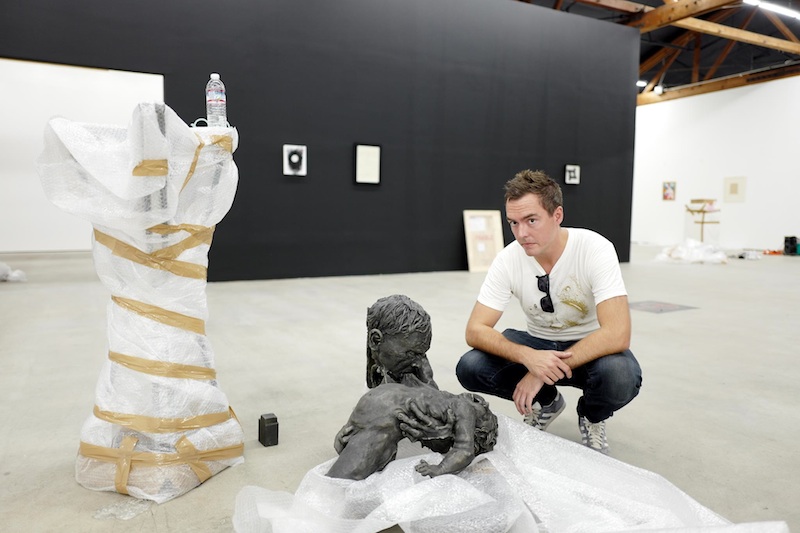
Portrait of Aaron Moulton // Photo by Stefan Simchowitz
Liam Casey: You’ve established yourself as Senior Curator of Exhibitions at Utah Museum of Contemporary Art in Salt Lake City, founder of the Feinkost Gallery in Berlin, Exhibition Programmer at Gagosian Gallery in Beverly Hills, and now you’re the Director of Venus L.A. What impressions have these various cities, and the establishments to which you’ve been attached, made on you in the trajectory of your career?
Aaron Moulton: There’s a very important inconsistency to my career path that’s been about adaptability. I’ve worked on both sides of for-profit and non-profit organizations. I’ve run magazines, Flash Art International. You ultimately get to understand this whole spectrum of what cultural production within visual arts is about when you walk in those different shoes. I think I’ve consciously pursued these different directions to put myself into a discomfort zone and learn how cultural ecologies work from different points of view. And that leads into the cities. I mean, each of these cities has their own ecosystems, their own rules, tribalism, or cultural way in which it’s put together and different languages that they’re speaking—not just in terms of language itself, but just what resonates as aesthetic sensibilities or cultural echoes. So like, art from Salt Lake City on the surface looks really conventional like abstraction or landscape. But once you dig a bit, you find things that are not so forthcoming in terms of ideas or ways in which things are infused with religion, or, how, oppositely, things are reactionary to the religious conditions and based on aesthetics of repression.
LC: And so did you feel like a lot of the art that was being exhibited in Salt Lake City, was very much directed and linked to the Utah Mormon spirit and culture?
AM: Inevitably. Even when they’re totally disconnected they’re somehow connected because it’s such an omnipresence there. The other interesting thing about Utah is it’s very tribal, there is no universality. It’s all tribalized. It’s a lot of consensus groups flowing with whatever the most confident sort of statement is at the times, and that’s not even usually a singular thing. Utah was actually more nuanced and more interestingly problematized by the cultural ecology there, because you have the church in the center defining everything, and you have BYU, which is an arm of the church but with an academic approach, trying to create a contemporary art of Utah. And then you have former Mormons who are somehow using their background in religiosity, or whatever that means, to have walked away from that as some integral part of their practice. But then you have people that are dealing with the landscape, which is from the land art of Robert Smithson to the basic plein air.
Then, there’s the institutional positions and then there’s a whole kind of vein of cinema that’s not necessarily based on Sundance’s influence there, but rather it’s based on Trent Harris, an interesting filmmaker from Utah who’s part of an interesting gonzo telejournalism movement. And so, none of these interconnect really. They only do so in the fact that they’re in Utah. In Utah, you have seven or eight really solid well-defined art worlds that don’t interlace easily. To see that there was really the first time it cohered for me how my practice could play out in a way, to pull from these different groups and try to interlace them. And that’s what I do now. It’s full anthropology but masquerading in a contemporary art vernacular.
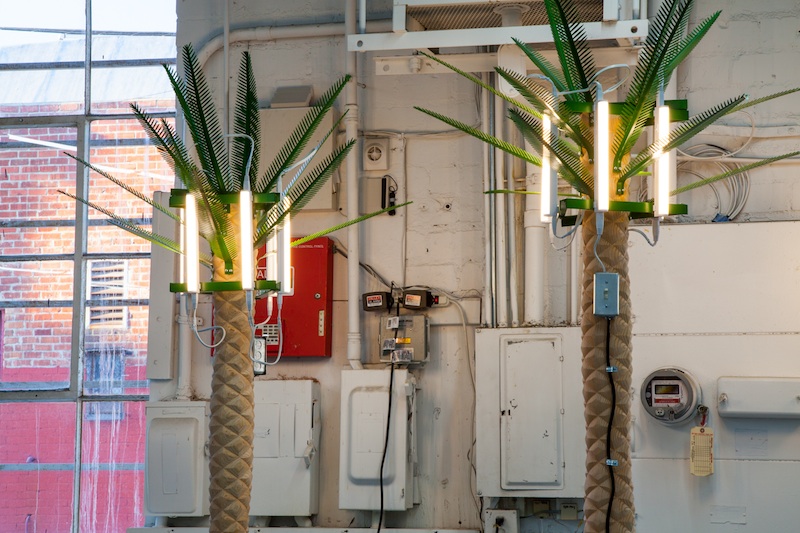
Aaron Moulton, curator, ‘Concrete Island’, 2017 // Photo by Lazaros
LC: Just as Berlin has undoubtedly affirmed itself as the nexus of contemporary art in Europe, Los Angeles has positioned itself as a counterpart to the established art world in New York. Seeing as how you have worked and spent time in both cities (Berlin and L.A.), how do the cities compare with their approach to contemporary art?
AM: Well, I lived in Berlin from 2007 until 2012, and this was a moment where it was fashionable to move there. Berlin interestingly goes through molting periods; by the time I left there were things happening that made me realize my day was past, like this is no longer my generation or things are changing or I was in need of changing. At the time I came to Berlin there was a lot of hopeful potential in what Berlin was going to be as an art world center, lots of influx and migration to it. And the reality of Berlin was that it didn’t prove itself to have the economic elasticity that it was hoped to potentially offer. And it also is ultimately a very provincial place.
LC: There are still vestiges of the Cold War and East Germany. It never became the economic powerhouse that the government imagined.
AM: No, it didn’t. I mean it’s a great place for artists. But I’m an infrastructure person. It was fantastic to grow in that place and with the artists there. But, the reality is, it is an environment that didn’t have an economic growth ability that I could grow with. I found that Berlin is a place that you need to know when to leave; it has a shelf life. But it’s kind of like a ‘Neverland’. But I needed to go. I was out of money and I needed to salvage a career. And so I left.
It never occurred to me to move to L.A. I’ve had the good fortune to live in a lot of good cities that were in the light of that shifting art world, compass-pointing direction. But I feel like, again, I’m living in L.A. at this perfect time of this city and what our expectations of it are. And the interesting thing is that it is a place that actually does have that elasticity. It will continue to grow, definitely. People will continue to come here no matter what. It’s not going to go out of fashion because we’re all these creatures of climate. And I think this world here, the real estate market will continue to be hyper-competitive. Hollywood is only just waking up to its potential to influence the conversation. In terms of the art world itself, artists are going to continue coming here. The market here is still in a nascent phase. But I think the reality here is a fascinating one in that it’s got that potential and it’s going to continue to be a sought-after place.
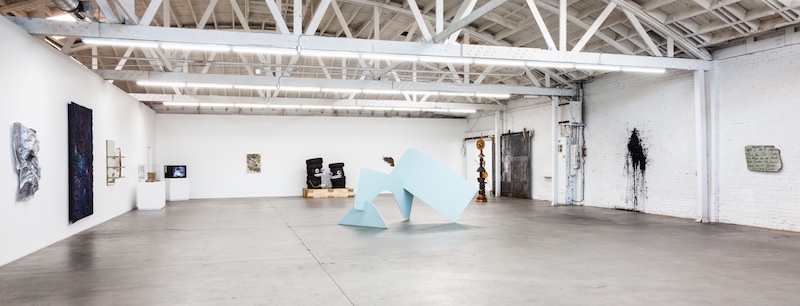
Aaron Moulton, curator, ‘Concrete Island’, 2017 // Photo by Lazaros
LC: You often incorporate themes of religion, the occult, psychology and memory into your exhibitions. Can you explain what attracts you to these subjects in your curatorial practice?
AM: Well, the art world as I see it could be compared to a cult in denial. It subscribes to value systems that are very esoteric, hard-to-define, ever-changing. We are turning worthless into priceless in a snap, and that’s fascinating. It’s just an energy system, it’s how cultural energy systems work. For me, what’s interesting is how the origins of art are shamanic. And then religious interests, once you bureaucratize the creative madness, become these institutions of the shaman or the church, and then eventually of the market. Here, now, we’re in the most secularized point of western culture. And yet, we are in a church. We act as a sidewalk preacher and yet look for a confident voice to show the way. We are fully engaged in religious practice, somehow.
For me, what’s interesting is the irrational mind and what the irrational mind has to offer as an opportunity that we can put on a spectrum from dreams and boredom to madness. But, ultimately, it’s the irrational mind that is the best thing about being human. It’s going to be the hardest thing for computers to replicate. Failure is not something that computers do intentionally. And so failure is this gift we have. And I think that is where the successful, creative act—the mutation, the anomaly—that’s where all these things come from. And that is in large part going against logic and going against the rational. Psychology is the analysis of mind and how it’s built up and how it falls apart. And occult systems are these fantastic, alternative dimensions of thinking. And memory is this trick, a game we are playing with this civilization.
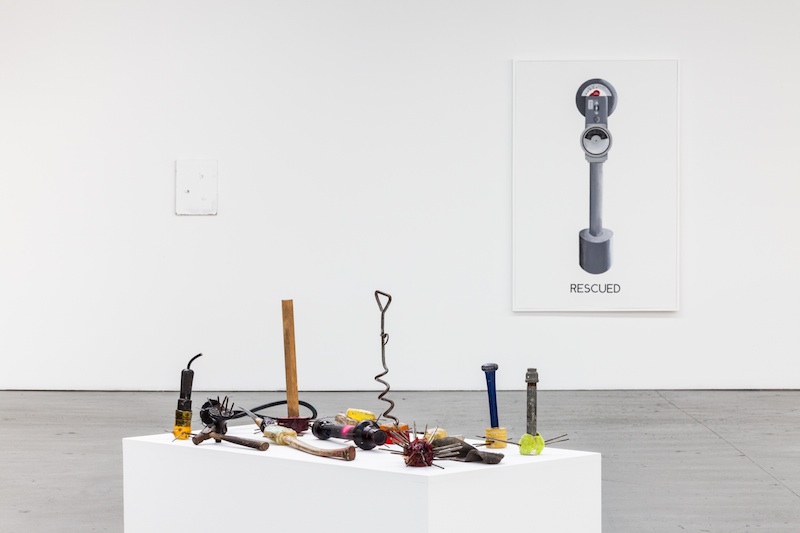
Aaron Moulton, curator, ‘Concrete Island’, 2017 // Photo by Lazaros
LC: You organized a show, ‘Omul Negru’, at Nicodim Gallery in Bucharest, Romania. The show examined how evil and the bogeyman can manifest themselves in people’s childhoods and how these same fears and anxieties are thus translated into adulthood. What inspired you to curate this exhibition?
AM: It’s about a universal aesthetic experience, which is a dangerous term. I feel like it will immediately make someone respond “That’s a white privilege statement”, but it’s not, because we are much simpler than we allow ourselves to believe. We’ve just become nuanced through the bureaucracy of society into these hyper-specific stereotypes. But the reality of a human being is that it is an animal and it comes from nature and it has very primal relationships to the world around it that we try to bureaucratize; evil being one of them, which is a way to bureaucratize nature’s will. So, I don’t know if evil really exists. I definitely know that good is more of a construct than evil. Evil is based on entropy; good is a thing we associate with order and civilization. Our natural impulse is to satisfy; fuck, eat, kill if necessary, to get those things. And so, the impulse to do a show about evil was more than just to do something that was gothy; I didn’t want it to be about these representations of evil. It had to be evil. I wanted it to go beyond a safe space of what art normally does.You know the problem with the art space is that it is such a bureaucratized location for the art experience, that you are so pre-conditioned to have an art experience that you probably won’t have one, because you are hoping to have one. So, the interest for me was to take that, what is ultimately a cynical view on a viewership, and try to really fuck with it and put it in an awkward place, so not just to have these representations of evil but to have things that were in their very essence, in their very molecular structure, evil. What I’m working really hard to do is create an occult system of my own. I’m not interested in creating anything that would be like a religion, but I want it to be like a religious experience.
LC: An installation of ‘Omul Negru’ subsequently opened in Nicodim’s Los Angeles outpost. As Dracula or Nicolae Ceausescu is to Romania, so is Charles Manson or Richard Ramirez to Los Angeles. Considering the two disparate geographic locations and their separate histories of bogeymen and evil, did the respective exhibitions’ meanings change when reinstalled in a different city and reintroduced to a different audience?
AM: All the extremism of the show was in Bucharest. I was playing around with a very hard stereo-typology of evil, by doing a show like that in Romania, where you think of Ceausescu or Dracula and gypsies and dark European corners. So it helped play into a lot of stereotypes—activate these stereotypes in a productive way. First of all we weren’t going to do the rituals that were in the Bucharest show in L.A., because it’s too sensitive of a culture in America. So, for me I was skeptical what it meant to do it here. And the other thing is in Romania you have a much more naturally activated sense of irrational thinking. It’s a very religious culture, it’s a very superstitious culture. So you had people who did not want to be in that show, who were scared of it, who were very taken by it. For me, it’s like these are experiments. I’m interested in audience dynamics. I don’t know what they lead to but they’re really about playing with the placebo effect very hard. And so I do see my work very seriously as anthropological practice. I’m actually creating these systems and inhabiting them as well, as well as understanding them. And I know that sounds really over-inflated as a kind of concept of one’s research, but I take them quite seriously for the opportunity they offer in analyzing energy. So L.A. was good.
LC: What projects are next on the horizon for you in L.A.?
AM: Venus is my life now. This is an amazing place. I started here in the beginning of January and I think my career has been trying constantly to evolve with my environment. Adam Lindemann created this project in this great way to make an anomaly in the art world. We don’t represent artists, technically. We have relationships that we are creating, but that’s already a first big deal. All commercial art galleries are identified by having a stable of artists that they work with. And so Adam’s not only been this force within the market of the art world but also in multiple markets in different cultural worlds. What he’s done with Venus over Manhattan, is make a lot of historically important exhibitions that have had unprecedented aspects to them: a masterfully installed survey of Maurizio Cattelan sculptures, or right now we have a stellar John McCracken planks show, which is a fantastically nutritious spectrum showing the diversity of the plank.
He saw in me this opportunity to organize the program for the space here in L.A., which is one of the biggest galleries in L.A. It’s a great opportunity to make a culture bomb here. I like what Adam does in terms of discovering artists, also. He’s somebody who reemerges important lost talent and really puts them out there in an important way. And I’m operating more at an esoteric end of things, in terms of who I think are cultural voices that are being underrepresented. And then, of course, I make group shows.
LC: Could you talk a bit about the upcoming show on J.G. Ballard’s ‘Concrete Island’?
AM: Yes, so this is a show I put together, which has 30-some artists mostly from L.A. The show is dramatized visual culture based on a book of J.G. Ballard’s called ‘Concrete Island’. It fits into his ‘Urban Disaster Trilogy’ and is flanked by ‘Crash’, and then, after ‘Concrete Island’, he wrote ‘High Rise’. ‘Concrete Island’ is an important story in how it outlines the will of man to survive and overcome difficulty. It’s a story about a guy who’s thrown off the highway and into a non-place, a kind of location between the highway interchange, and he’s stuck there and marooned in plain sight like an inner-city Robinson Crusoe. He’s got to survive. And Ballard, of course, paints an entire world with his fantastic writing style that really is about what it looks like when nature wins in the urban environment.
So, this is a show that looks at different things stemming from issues of the non-place in the meta-city, which is the essence of L.A. There’s a heavy aspect of the show that deals with aesthetics of Hobo shamanaism and contemporary primitivism, and the way visual cultures bring out the surrealism of solitude and that magical thinking that comes into play from solitude, when the world doesn’t see you anymore. This show is a lot about survival offering an avant-garde transcendence. It’s divided into two parts, I would say 4 to 6 exhibitions are happening in this one show, in order to create a world. I’ve tried to make it less an homage to Ballard’s book and more an autonomous vacation destination born in the festering cracks of civilization. Welcome to Concrete Island. And the viewer is Ballard’s protagonist trying to figure their way throughout their new home, one that blurs the walls of the white cube with the world outside.
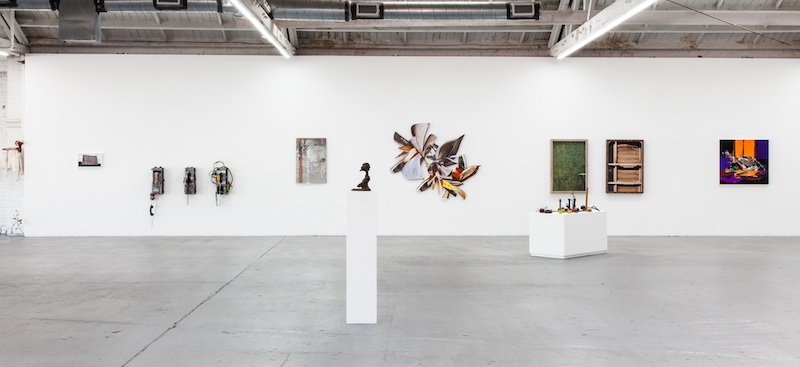
Aaron Moulton, curator, ‘Concrete Island’, 2017 // Photo by Lazaros
Exhibition Info
VENUS
Group Show: ‘Concrete Island’
Exhibition: Mar. 11 – May 13, 2017
601 South Anderson Street, Los Angeles, CA 90023, click here for map


























